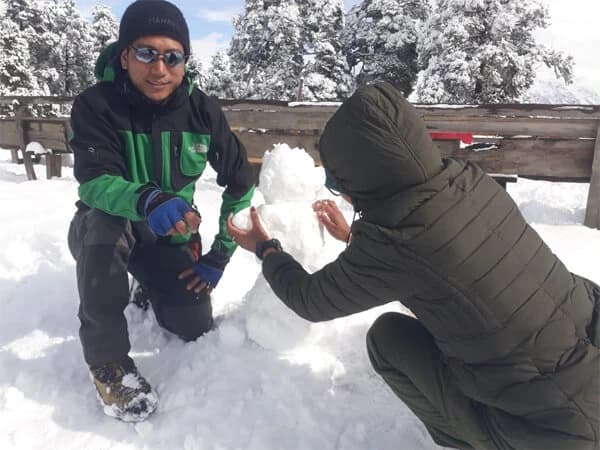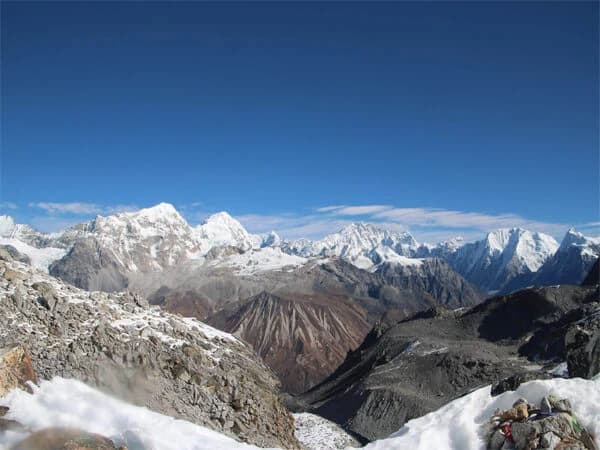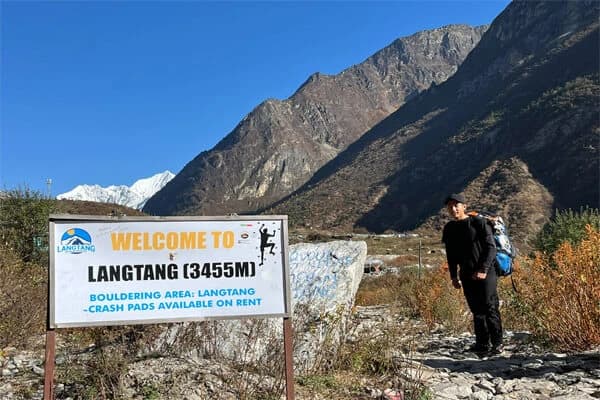The Ganjala Pass Trek is one of the most adventurous and less-traveled trails in the Langtang region of Nepal. Its raw beauty and genuine difficulties that force trekkers to step beyond of their comfort zone are what really set it apart. The Ganjala Pass, which is approximately 5,106 meters above sea level, is renowned for its rocky paths, steep ascents, and snow- and ice-covered areas. This makes the Ganjala Pass Trek difficulty level high and best suited for seasoned trekkers seeking a genuine Himalayan experience.
The Ganjala Pass trekking trail leads you into isolated areas with few amenities and unspoiled scenery, in contrast to well-traveled trekking routes with cozy tea houses and clearly indicated routes. The Ganjala trek is challenging and rewarding due to its high elevation, erratic mountain weather, and steep aspects. It requires trekkers to be mentally tough, physically healthy, and well-prepared. But every step is rewarding because of the stunning views of Langtang Lirung, serene yak pastures, Buddhist monasteries, and hospitable local people.
We will go over all you need to know about the difficulty of the Ganjala Pass Trek in this blog, including the obstacles, how to prepare, the weather, and who should try this adventure.
How Difficult is the Ganjala Pass Trek?
Overall Ganjala Pass Trek Difficulty Level
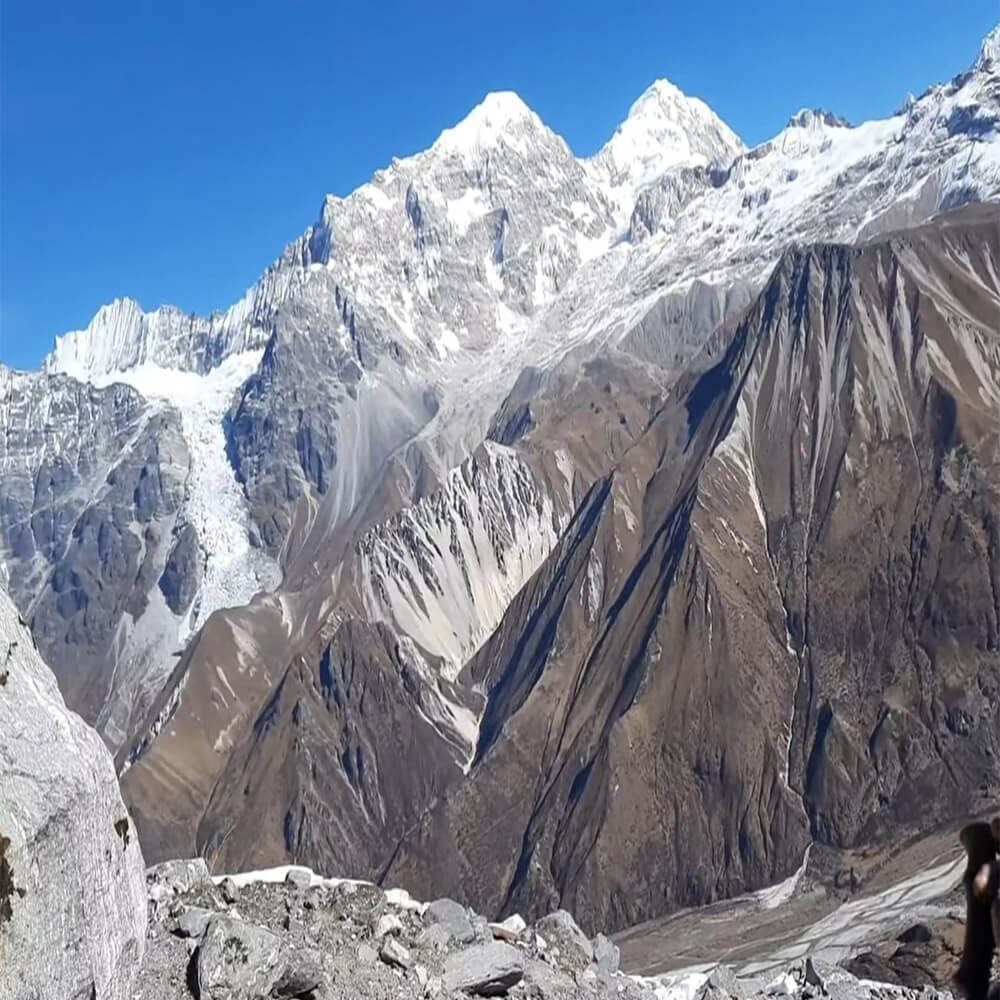
The Ganjala Pass Trek difficulty level is considered strenuous and challenging. Because of its high elevation, isolated location, and difficult terrain, this journey is among the most difficult in the Langtang area. Ganjala Pass, the trek's highest point, at 5,106 meters above sea level, where oxygen concentrations sharply decline. To endure long walking distances, challenging ascents, and frigid conditions, trekkers need to be emotionally and physically prepared. This trail is less well-traveled and draws fewer trekkers than well-known climbs like Everest Trekking or Annapurna Base camp Trek, which makes it both more daring and more difficult.
Ganjala Pass Trekking Grade
The majority of trekking experts categorize the Ganjala Pass trek as either "Advanced" or "Grade: Difficult." This indicates that there are parts of the route that would call for technical expertise, particularly in ice or snowy weather. Trekkers may need to utilize ice axes, crampons, or ropes for safety in some places close to the pass. The trail is susceptible to severe winds, limited spaces, and slippery conditions. Rescue services, medical facilities, and lodging alternatives are quite restricted due to its isolated location. Ganjala Pass trekking grade is therefore unsuitable for beginners.
Altitude and Acclimatization Challenges
Altitude is a major factor in the high difficulty level of the Ganjala Pass Trek. The danger of Acute Mountain Sickness (AMS) rises while trekking over 4,000 meters. Trekkers may experience headaches, dizziness, or shortness of breath as the air becomes thinner as they draw closer to the pass. In locations like as Kyanjin Gompa, proper acclimatization days are crucial. Climbing too quickly increases the risk.
Trekking Trail and Weather Conditions in Ganjala
Particularly close to the pass, the route has snow-covered areas, steep climbs, and rough roads. Deep snow can block the crossing in the winter and early spring, making the Ganjala crossing trekking grade much more challenging. Bright sunshine might rapidly give way to snow or high winds in a matter of hours.
To put it simply, the Ganjala Pass Trek is challenging yet worthwhile. For seasoned trekkers who enjoy isolated paths, excitement, and the raw beauty of the Himalayas, it is ideal. It is possible to make this difficult trek a memorable one with the correct planning, direction, and regard for the mountains.
Ganjala Pass Trekking challenges
The extreme altitude, isolated terrain, and severe weather make the Ganjala Pass Trek one of the most difficult treks in the Langtang region not because it is particularly long. Before trying this route, trekkers should be ready for the main obstacles listed below.
High Altitude Trekking in Langtang Region
Altitude is one of the trek's main obstacles. At 5,106 meters above sea level, Ganjala Pass has a thin atmosphere with low oxygen levels. Symptoms including headache, nausea, dizziness, and shortness of breath are common among trekkers. Altitude sickness has the potential to become severe if improperly treated.
It is important to properly acclimate; staying overnight at locations like Kyanjin Gompa aids in the body's adjustment. Avoiding alcohol, walking slowly, and drinking lots of water also lower the risk of AMS.
Weather Conditions at Ganjala Pass
Around Ganjala Pass, the weather is very erratic. The temperature can fall below freezing even during the busiest trekking seasons, particularly at night and in the early morning. The last ascent to the pass is challenging due to strong winds. Because of the ice and snow, the trail is hazardous and slippery.
Conditions like fog or whiteout can make it harder to see, which makes being lost more likely.The walk becomes significantly more dangerous during the winter and monsoon seasons because of landslides, thick snow, and obstructed paths.
Technical Sections on Ganjala Pass
In contrast to standard teahouse treks like Everest base camp or Annapurna circuit, Ganjala Pass has several semi-technical parts. The ascent to the pass is difficult and frequently snow- or ice-covered. Trekkers may need to utilize ice axes, ropes, and crampons for safety in some areas. The path is mostly dependent on the guide's expertise and the state of the trail because there are no fixed ropes or ladders. Narrow ridges, icy areas, and loose rocks need strength, balance, and mental concentration.
Trail condition and terrain of Ganjala Pass
Particularly close to the high pass, the Ganjala Pass trail is difficult, isolated, and steep, with scree slopes, rocky roads, and sporadic snow or ice. Trekkers must use caution when walking on uneven terrain, narrow ridges, and steep ascents and descents. Higher up, the scenery turns bleak, with glaciers, moraines, and bare cliffs; lower down, pathways wind through woods, alpine meadows, and tiny villages. Rapid weather changes could obscure or make routes slippery. All things considered, the terrain rewards trekkers with breath-taking panoramic vistas of the surrounding Himalayan peaks, but it also demands good endurance, trekking experience, and the right equipment.
Remoteness and Limited Facilities
One of the most isolated areas of the Langtang region is home to Ganjala Pass. In contrast to well-traveled trekking paths, this trail features:
- Less lodges or tea houses, particularly after Kyanjin Gompa.
- A lot of trekkers have to camp or carry tents, which makes the trip heavier.
- Once you leave the main villages, there are no stores or locations to purchase supplies, and the food options are simple and restricted.
Rescue services and medical assistance are difficult to come by due to the distant location. The sole choice in an emergency is a helicopter rescue, which may be postponed because to bad weather or financial constraints.
Physical and Mental Demands
Walking six to eight hours a day is necessary for this trek, which frequently takes place on rough, hilly, or snowy paths. Breathing becomes challenging because to the thin air, and it might be tiring to wear a backpack.Trekkers require mental toughness, perseverance, and composure. For many who are not mentally prepared, the loneliness, chilly evenings, and difficult treks can be too much to handle.
Altitude, weather, remote terrain, and physical challenges all contribute to the Ganjala Pass Trek's difficulties. These obstacles may be overcome, though, with the correct planning, direction, and perseverance, making the journey a fulfilling and transformative experience.
Best season for Ganjala Pass trek
Although trekking to Ganjala Pass is rewarding, the season you choose has a significant impact on your safety and overall enjoyment. Not all seasons are appropriate due to the trail's high elevation, snowy passes, and erratic mountain weather. Here is a thorough analysis of the ideal and worst times to trek Ganjala Pass.
Ganjala Pass Trekking in Spring Season(March to May)
A popular season for the Ganjala Pass Trek is spring. In comparison to winter, the temperature is higher, the skies are clearer, and the weather is consistent. The route becomes more accessible as snow starts to melt from the upper passes. Particularly in the lower portions of the Langtang Valley, the paths are alive with vibrant wildflowers, pine trees, and blossoming rhododendrons.
In locations such as Kyanjin Gompa and the Ganjala Pass region, mornings and evenings might still be extremely cold, but daytime temperatures are tolerable. There is less chance of snowstorms and great visibility of summits including Yala Peak, Dorje Lakpa, and Langtang Lirung. The beauty and doable challenge of this season are well-balanced.
Ganjala Pass Trekking in Autumn Season (September to November)
The best and most dependable time of year for trekking to Ganjala Pass is in autumn. The air is fresh, the skies are clear, and the mountains seem incredibly beautiful and crisp after the monsoon rains. The moderate daytime temperatures make it more comfortable to walk for extended periods of time.
Because the trail is dry, there is less chance of landslides or slippery surfaces. Although it is still simpler to cross the divide since heavy snow has not yet begun, high-altitude areas are still frigid. Due to the occurrence of important Nepali festivals like Dashain and Tihar, particularly in the lower villages, autumn also has some cultural beauty. Autumn is the ideal season for trekkers looking for the most picturesque and safest conditions.
Ganjala Pass Trekking in Monsoon Season (June to August)
The monsoon season brings with it a lot of rain, overcast skies, and slippery roads. Trekking is hazardous due to landslides, leeches, and limited visibility. The Ganjala Pass region is susceptible to unexpected snowfall or rain, making an attempt dangerous.
Ganjala Pass Trekking in Winter Season (December to February)
Because of the severe snowfall, freezing temperatures, and closed high passes, winter trekking is quite challenging. Ganjala Pass's trails can icy and call for specialized gear. Only trekkers with a lot of experience should think about this season.
Required Fitness and Experience for Ganjala Pass Trekking
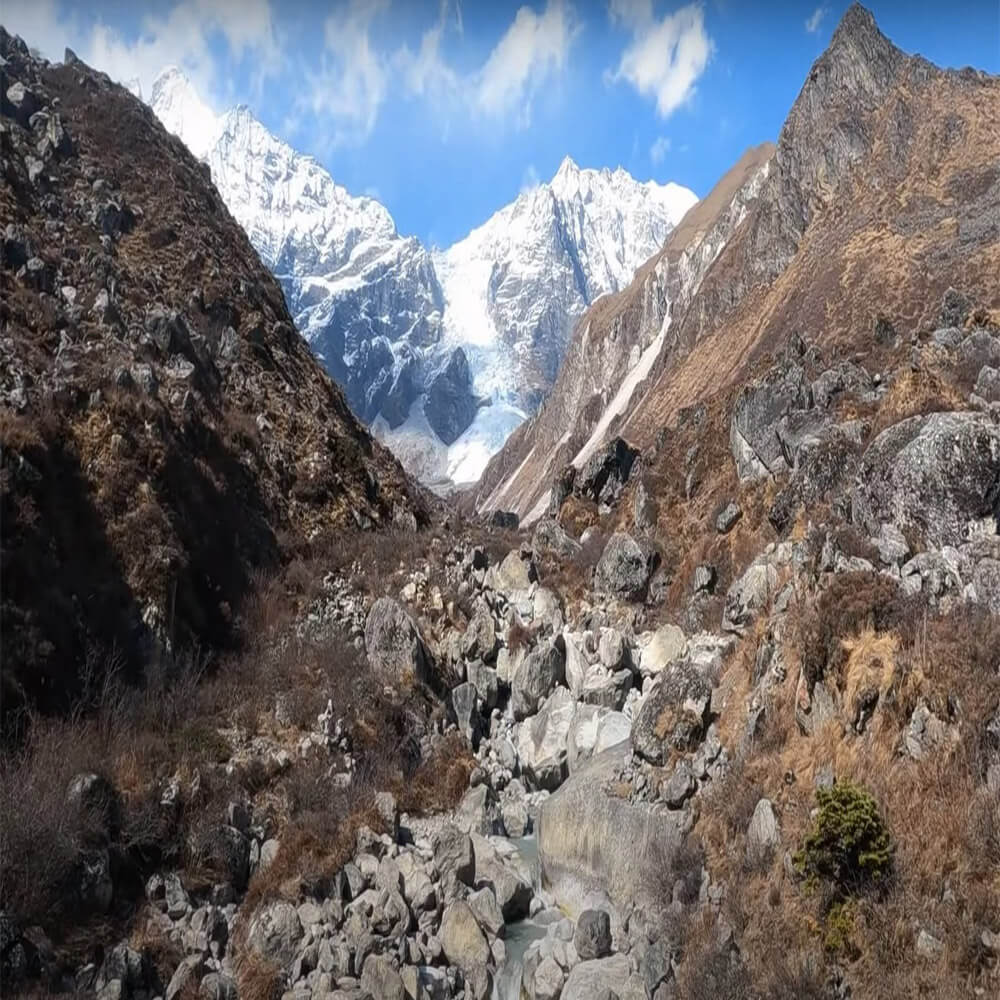
You need to be physically prepared and have some trekking experience in order to finish the Ganjala Pass Trek safely and with confidence. Walking alone is not enough for this high-altitude trek; strength, endurance, and mental tenacity are required.
Physical Fitness for Ganjala Pass Trek
One of the key success elements for the Ganjala Pass trek in Nepal is physical conditioning. The trail entails long trekking days, typically lasting 6 to 8 hours, with rocky terrain, high ascents, and occasionally traversing snow and ice. At 5,106 meters, the pass itself puts more effort on your body and provides less oxygen. Trekkers should begin training two to three months prior to their journey in order to get ready.
Prioritize cardiovascular activities such as swimming, cycling, running, and backpack trekking. Your heart and lungs will adapt better to prolonged walking at high elevations if you do these exercises. Strength in the legs is similarly vital. Step-ups, stair climbing, lunges, and squats will strengthen and stabilize your legs on uneven terrain. Particularly when carrying a backpack, core workouts like planks and sit-ups aid in maintaining balance.
Trekking Experience Required for Ganjala Pass
Compared to other climbs like Langtang Valley or Annapurna Base Camp, Ganjala Pass requires a greater level of trekking experience. The fact that this walk travels through isolated regions with occasionally hazy routes and rapidly shifting weather makes it challenging. It is extremely suggested to have prior experience trekking at elevations above 4,000 meters.
You will be better equipped for the Ganjala Pass if you have done treks like the Annapurna Circuit, Manaslu Circuit, or Everest Base Camp. You learn how to keep a steady pace, when to rest, and how your body responds to altitude from these experiences. It also helps to know how to walk on snow, use trekking poles, and handle cold weather. Although technical climbing skills are not always required, having a basic understanding of how to use ropes or crampons can make the trip safer.
Why Mental Preparation Matters?
Mental readiness is just as important as physical prowess and expertise. You will have to deal with chilly mornings, sore muscles, subpar accommodations, and occasionally no mobile service. You can overcome challenging parts and enjoy the journey by remaining upbeat, patient, and focused.
Completing the Ganjala Pass Trek successfully requires a high level of physical fitness, appropriate training, and previous trekking experience. The correct attitude and planning can turn this difficult trek into a fulfilling Himalayan accomplishment.
Guide and Safety Requirements for Ganjala Pass Trekking in Langtang Region
How Importance is Trekking with a Guide?
A key recommendation in any Ganjala Pass trek preparation guide is to work with a qualified and experienced trekking guide. Ganjala Pass's trail is poorly marked and frequently covered in snow, particularly in the area close to the pass. There are places where the road entirely vanishes, making it dangerous to navigate without the right information. A qualified guide is familiar with weather trends, safe routes, and emergency escape routes. They can guarantee proper handling of permits and logistics and aid in communication within nearby areas. A guide becomes your first line of defense in situations like altitude sickness or injury.
Essential Safety Gear and Equipment
One of the most important aspects of the Ganjala Pass trek preparation guide is packing the appropriate equipment. Due to the pass's elevation of nearly 5,100 meters, trekkers need to prepare for icy paths, chilly winds, and abrupt weather shifts. Among the necessary tools are:
- Thermal layers and insulated coats for chilly climates.
- Trekking boots that are waterproof and have good traction.
- Trekking poles, ropes, and crampons for areas that are slippery or snowy.
- Suitable sleeping bag (rated at -15°C or below).
- Sunscreen, sunglasses, a first aid kit, and a headlight.
- On rugged terrain, these things keep you comfortable and safe.
Travel Insurance and Emergency Plans
Emergency preparation is one of the aspects of trekking that is most often neglected. It becomes crucial during Ganjala Pass, though. You should purchase travel insurance that includes coverage for helicopter rescue and high-altitude treks. Given the high cost of uninsured rescue services, this is one of the most sensible safety precautions for the Ganjala Pass trek. In severe situations, air evacuation might be the only option because most of this trek's locations lack hospitals or clinics. Always let family members or trekking organizations know your itinerary and emergency contacts.
Health and Altitude Safety for Ganjala Trek
One of the main hazards of this trek is high altitude. Therefore, every preparation guide for the Ganjala Pass trip must cover acclimatization. Before you cross the pass, stay at Kyanjin Gompa for at least one or two nights. Recognize the signs of acute mountain sickness, which include headache, nausea, lightheadedness, and appetite loss. If symptoms get worse, descend immediately. Hydration, slow walking, and avoiding alcohol are key safety tips for Ganjala Pass trek.
By keeping these guide and safety requirements in mind, trekkers can enjoy the adventure while staying secure in the high-altitude wilderness of the Ganjala Pass.
Acclimatization and Itinerary Planning
Understanding Ganjala Pass Elevation Gain
The significant elevation gain at Ganjala Pass is one of the trek's main obstacles. Trekkers ascend steadily through the Langtang Valley to reach Kyanjin Gompa at 3,870 meters after beginning in Syabrubesi, which is around 1,500 meters above sea level. The trail then climbs above 5,000 meters, becoming progressively steeper, until it reaches Ganjala Pass at 5,106 meters. The body is under a lot of stress due to this abrupt elevation change. In the absence of adequate rest and a leisurely pace, the likelihood of experiencing respiratory issues or exhaustion increases significantly. For this reason, it is crucial to schedule ample acclimatization days.
Altitude and Acclimatization in Ganjala Pass Trek
A safe voyage during the Ganjala trekking depends on the altitude and acclimatization. Allowing your body to acclimate to the reduced oxygen levels at high altitude is known as acclimatization. The majority of trekkers stay at Kyanjin Gompa for at least one additional day, visiting neighboring vantage spots like Kyanjin Ri and Tserko Ri. Before climbing the high pass, these day treks aid in the body's adjustment. Additionally, it is critical to abide by the phrase "climb high, sleep low." This entails climbing higher during the day and then descending to a lower location during the night.
Ganjala Pass Altitude Sickness Risk
It is important to take seriously the possibility of altitude sickness at Ganjala Pass. Because there is significantly less oxygen in the air over 5,000 meters, headaches, nausea, lightheadedness, and appetite loss may result. Acute Mountain Sickness (AMS) manifests as these symptoms. Trekkers are required to descend right away if they have severe symptoms such as dyspnea, disorientation, or frequent vomiting. Neglecting these indicators may result in potentially fatal illnesses such as High Altitude Pulmonary Edema (HAPE) or High Altitude Cerebral Edema (HACE).
Planning a Safe Itinerary for Acclimatization
An intelligent itinerary is crucial to lowering hazards. Before continuing on to Ganjala Pass, spend at least one or two nights in locations like as Kyanjin Gompa and Langtang Village. Drink plenty of water, consume warm food, and abstain from smoking and alcohol. Regarding route safety and weather, trekkers should also speak with their guide.
Proper planning for altitude and acclimatization in the Ganjala Pass trek not only reduces risk but also makes the journey more enjoyable and safe.
Ganjala Pass Trek vs Langtang Valley Trek Difficulty
Although both the Ganjala Pass Trek and the Langtang Valley Trekprovide breathtaking Himalayan views, there is a notable variation in difficulty between the two.
The Ganjala Pass Trek is considered a difficult and demanding high-altitude trek. At 5,106 meters, the pass itself poses a serious danger of altitude sickness. In addition to long trekking days that last an average of 6 to 8 hours, trekkers must contend with steep, rocky, and occasionally snowy routes, especially in the vicinity of the pass. Trekkers frequently carry more essential gear or rely significantly on guides and porters because the area is remote and has few lodges and minimal amenities. The weather can be erratic, and situations like snow, wind, and frigid temperatures can make things more challenging. This trek is best suited for seasoned trekkers who have been to high altitudes before, are physically fit, and are mentally prepared for challenging, isolated terrain.
The Langtang Valley Trek, on the other hand, is regarded as moderately challenging. At about 3,870 meters, Kyanjin Gompa is the highest peak. This is substantially lower than Ganjala Pass, which greatly lowers the danger of altitude sickness. The well-traveled and typically safer trails wind through tiny settlements, forests, and along rivers. Trekking typically lasts four to six hours each day, and there are many lodges along the way. Langtang Valley is more approachable and beginner-friendly for trekkers seeking a balance of natural beauty and cultural immersion without significant hurdles, even though it still calls for some level of fitness and acclimatization.
Tips to Overcome Difficulties on the Ganjala Pass Trek
Although trekking to Ganjala Pass is difficult, you may make the trip safer and more pleasurable by doing your homework and using the right techniques. The following useful advice can help you overcome the challenges:
Start Training Early
Prior to the trek, concentrate on increasing your leg strength and endurance. Running, cycling, or swimming are examples of daily aerobic exercises that assist your lungs adjust to increased oxygen demands. One of the greatest methods to replicate trip conditions is to trek over rough terrain while carrying a full backpack. At least six to eight weeks before to your departure, begin your training.
Pack Smart and Light
Fatigue may increase if you are carrying big equipment on rocky, steep routes. Only bring the necessities: a sleeping bag, gloves, a hat, waterproof coats, trekking boots, trekking poles, and layered clothes. Make sure your backpack weighs no more than 10 to 12 kg. You can move more quickly and put less strain on your knees with light packing.
Stay Hydrated and Eat Well
Trekking at high elevation causes the body to lose water more quickly. For energy, eat foods high in proteins and carbs and drink two to three liters of water each day. Heavy meals are not as good as small, regular ones. Alcohol can exacerbate altitude sickness, so stay away from it.
Pace Yourself
Rushing through the trek is one of the worst blunders. Listen to your body, walk at a comfortable speed, and take rests. This method lowers the chance of altitude sickness and helps avoid fatigue.
Follow Your Guide’s Advice
For Ganjala Pass, it is imperative to hire a knowledgeable guide. Guides are familiar with the route, keep an eye on weather conditions, and offer assistance when needed. Always heed their recommendations, particularly when traveling on slippery or hilly terrain.
Prepare Mentally
The journey presents both a mental and physical hardship. Remain upbeat, show patience during challenging parts, and acknowledge minor victories along the way. Being mentally prepared will help you deal with exhaustion and unforeseen challenges.
You may conquer the difficulties of the Ganjala Pass trek and take in one of the most isolated and magnificent views in the Langtang area by combining appropriate training, astute packing, cautious pacing, and mental toughness.
Who Should and Shouldn’t Attempt the Ganjala Pass Trek
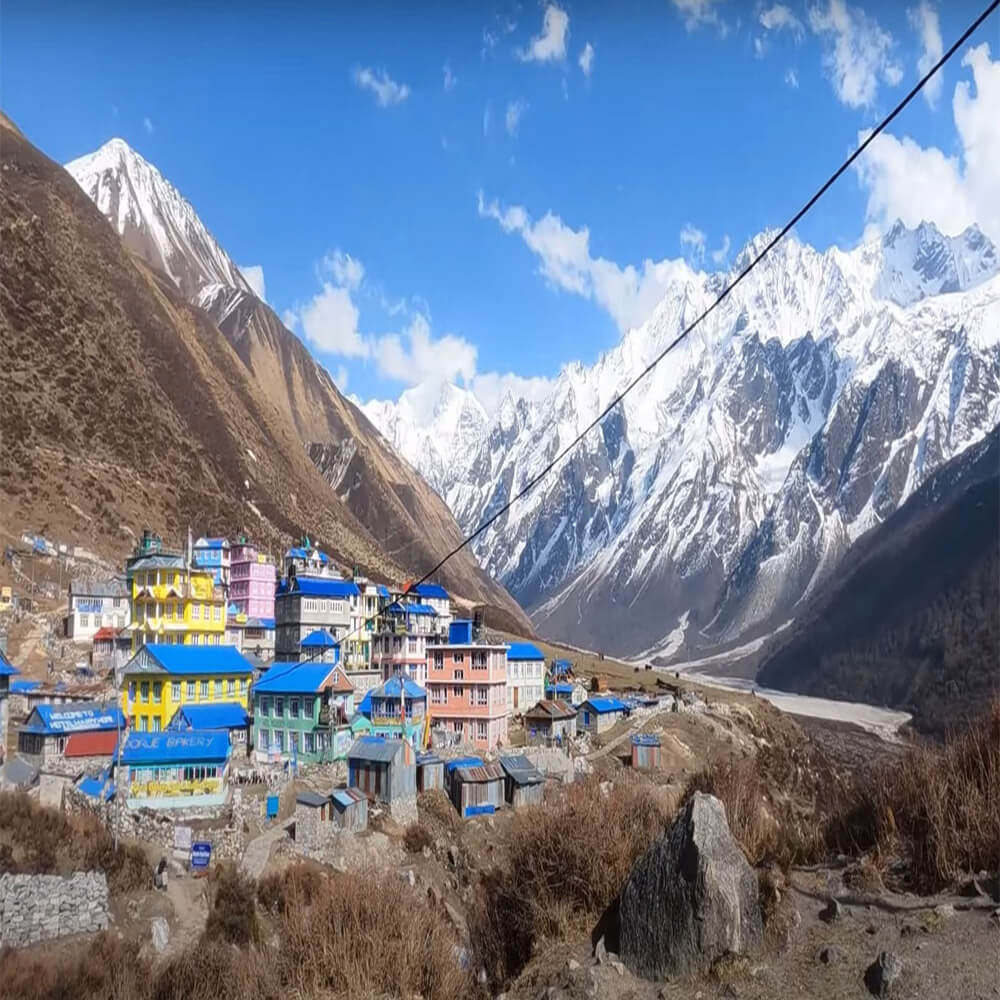
Although it is not for everyone, trekking to Ganjala Pass is a once-in-a-lifetime experience. You can prepare more effectively and have a safer trip if you know who should do this trek and who shouldn't.
Who Should Attempt Ganjala Pass Trek
Trekkers with expertise and physical fitness might consider the Ganjala Pass trek. If you are prepared, this journey will be manageable for you if you have done high-altitude climbs like Everest Base Camp, Annapurna Base Camp, or Langtang Valley. Trekkers must be physically fit to withstand long walking distances, high ascents, and rocky terrain. They must also have great cardiovascular endurance, leg strength, and stamina. Since the expedition entails traveling through isolated locations with few amenities and erratic weather, mental readiness is just as crucial.
This trek will be very fulfilling for those who are looking for peace, raw natural beauty, and cultural experiences in Tibetan-influenced Himalayan settlements. After climbing Ganjala Pass, adventurers who relish testing their mettle against high-altitude passes, snow-covered paths, and breathtaking alpine scenery will feel a sense of accomplishment.
Who Should Avoid Ganjala Pass Trek
Beginners or inexperienced trekkers should not attempt this trek. Thin air, steep climbs, and difficult terrain can be difficult for anyone who have never trekked at high altitudes before. Since emergency medical assistance is scarce in isolated areas, anyone with pre-existing medical conditions like heart, lung, or joint problems should avoid this walk. This expedition will probably be too taxing and difficult for trekkers who are more comfortable, prefer opulent accommodations, or prefer easy walking tracks. Additionally, those who are not mentally prepared for sudden weather changes, long walking days, or basic accommodation conditions may face difficulties.
Ganja La Pass trek difficulty FAQs
How hard is the Ganjala Pass Trek?
Ganjala Pass is considered a strenuous trek due to its high altitude (5,106m), steep trails, rocky paths, and occasional snow or ice. It requires good physical fitness and trekking experience.
Is Ganjala Pass trek suitable for beginners?
Beginners are generally not advised. The trek involves high-altitude challenges and technical terrain, making it more suitable for experienced trekkers.
What are the main challenges of the trek?
The trek poses high-altitude risks like Acute Mountain Sickness, unpredictable weather, remote locations with limited facilities, and physically demanding long trekking days.
How can I prepare for the difficulty?
Preparation includes physical training (endurance, cardio, leg strength), acclimatization during the trek, proper trekking gear, hiring an experienced guide, staying hydrated, and planning rest days.
How to train for Ganjala Pass trek?
To train for Ganjala Pass, focus on cardio, leg strength, and endurance through trekking, stair climbing, and running; include strength exercises, balance training, and gradual altitude exposure if possible.
What to expect on Ganjala Pass crossing?
On Ganjala Pass crossing, expect steep, rocky, and sometimes icy trails, breathtaking Himalayan views, cold winds, thin air, physical exertion, and a sense of achievement upon reaching the high-altitude summit.
Conclusion: Ganjala Pass trek difficulty
Unquestionably difficult, the Ganjala Pass Trek offers those who are ready a sense of genuine adventure and stunning Himalayan views. With the right preparation, acclimatization, and direction, the challenge steep ascents, high altitude, erratic weather, and inaccessible terrain becomes a path of accomplishment and self-discovery. Experience magnificent scenery, snow-capped peaks, and peaceful valleys unspoiled by mass tourism by trekking this pass. The final vista from the pass is very satisfying because every step requires concentration, perseverance, and respect for the natural world. Ganjala Pass is a place where challenging conditions become a remarkable experience for seasoned trekkers looking for a combination of physical challenge, cultural immersion, and raw Himalayan beauty.





